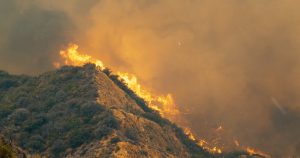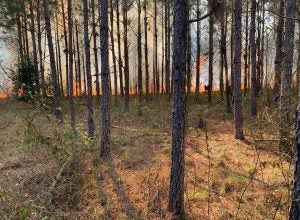Prescribed burning is a tool used in native landscapes and commercial timberlands across the world. There are many reasons why a land manager might use prescribed burning to enhance or manage the land.
One of the most beneficial results of prescribed burning, regardless of the intended end goal, is the reduction of fuel loads in the case a wildfire breaks out. Wildfires can be devastating for urban and rural communities across the country. In 2020, one of the worst most recent wildfire seasons in the United States, nearly 18,000 structures were lost to out-of-control fires, over half of those being homes. In the last decade, it has cost between $1.5 billion and $3 billion dollars each year for federal wildfire suppression tactics, including equipment and personnel.
The top 10 most destructive fires by financial losses have occurred in California, with the largest being the 2018 Camp Fire, which incurred over $10.4 billion in expenses for those affected. Wildfires aren’t just financially impactful, they can cause major environmental damage and be a nuisance to general human activities.

Of course, raging fires burning in the area means that road closures are likely, which impacts travel. In addition, smoke generated by wildfires can have strong effects on communities even hundreds of miles away as it is carried in the atmosphere. This can drop ash and particulate matter and impacts air quality, making it difficult for many to be outside. Communication can be impacted if fires approach telephone lines, cellphone towers, or even energy distribution centers.
You can see why minimizing wildfires would result in a reduction to impacts to human activity.
Environmental damage can be significant since wildfires often burn large swaths of lands, are high intensity, and have severe impacts. In 2020, nearly 60,000 fires in the United States, impacting over 10 million acres on the east and west coast. Typically more fires in the eastern states, but these fires are smaller in size and generally are less severe. Western states see marginally fewer fires than the East, but the western fires can be more intense and consume more acreage at once. This regional difference is generally seen because of the landscapes, the types of plants and fuel available to burn, as well as weather differences, particularly drought conditions. Wildfires impact plant communities and wildlife in the area, and overall have a negative influence on the environment.

It may seem weird to fight fire with fire, but there are “good fires” and “bad fires.” Prescribed burning are like a prescription written by a doctor — the “doctor” in this case being the land manager. The prescription details what the goals of the burn are, the weather conditions when the burn should be conducted for the best results and least human impact, and the intensity of the fire to achieve the results.
This prescription means that the fire will occur in a safe, controlled way with little impact on the environment or humans.
Prescribed fire does more than just prevent raging wildfires, it can also benefit native landscapes, improve food sources and habitat for wildlife, or control underbrush in timber stands. Many native plants across the world are designed for fire to occur, since fires would naturally occur long before human intervention. Some plants need fire for their seed pods to open, some need other plants to be cleared out by fire so their seeds can germinate and succeed, while others are designed to withstand fire with thick, insulating bark or waxy foliage.
Prescribed burners can tell you many stories of deer, turkey, quail, and other wildlife coming in immediately after a fire to consume plants and insects. Wildlife also benefit from improved nutrition in plants and better habitats in areas regenerating after a fire.

Prescribed fire might be a beneficial tool for your land too. Reach out to your local forest service or prescribed burn association to see how prescribed burning might be implemented on your property. This important resource is vital to protect and encourage with the way we vote, so make sure those in office know this issue matters to you.
Michelle Miller, the “Farm Babe,” is an internationally recognized keynote speaker, writer, and social media influencer and travels full time to advocate for agriculture. She comes from an Iowa-based row crop and livestock farming background and now resides on a timber farm in North Central Florida.



